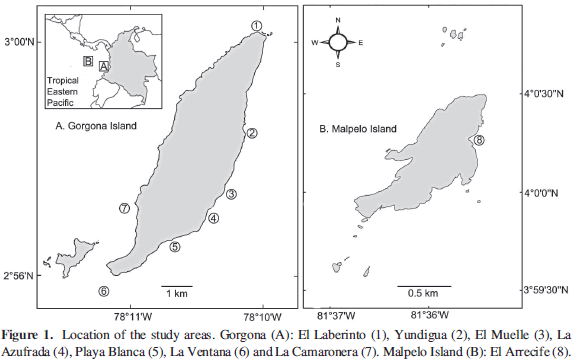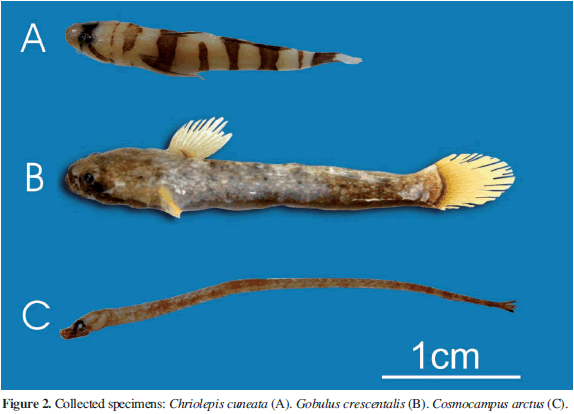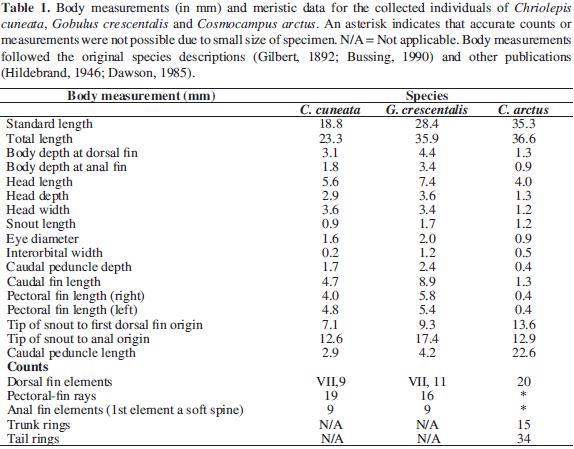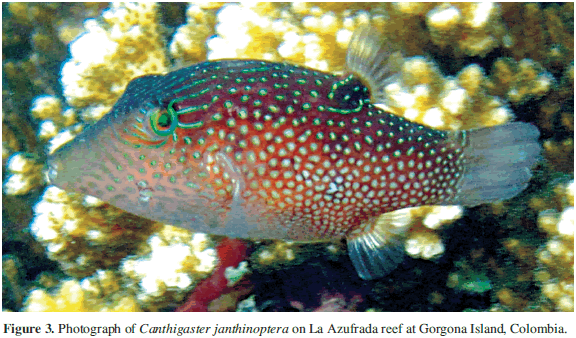Services on Demand
Journal
Article
Indicators
-
 Cited by SciELO
Cited by SciELO -
 Access statistics
Access statistics
Related links
-
 Cited by Google
Cited by Google -
 Similars in
SciELO
Similars in
SciELO -
 Similars in Google
Similars in Google
Share
Boletín de Investigaciones Marinas y Costeras - INVEMAR
Print version ISSN 0122-9761
Bol. Invest. Mar. Cost. vol.41 no.1 Santa Marta Jan./June 2012
NOTA:
NEW RECORDS OF CRYPTOBENTHIC FISHES IN CORAL REEF HABITATS OF GORGONA ISLAND, COLOMBIA, TROPICAL EASTERN PACIFIC
NUEVOS REGISTROS DE PECES CRIPTOBENTÓNICOS EN HÁBITATS ARRECIFALES CORALINOS DE ISLA GORGONA, COLOMBIA, PACÍFICO ORIENTAL TROPICAL
Adriana Alzate1,2, Carlos G. Muñoz1,3, Fernando A. Zapata1 y Alan Giraldo1
1 Universidad del Valle, Departamento de Biología, Grupo de Investigación en Ecología de Arrecifes Coralinos, AA 25360, Cali, Colombia. adria.alzate@gmail.com (AA); munozcarlosg@gmail.com (CGM); fernando.zapata@correounivalle.edu.co (FAZ); alan.giraldo@correounivalle.edu.co (AG).
2 University of Oldenburg, Institute for Chemistry and Biology of the Marine Environment ICBM, Mathematical Modelling Group, Oldenburg, Alemania.
3 Center of Excellence in Marine Science-CEMarin. Carrera 2 No. 11-68. El Rodadero, Santa Marta, Colombia.
RESUMEN
Se hacen cuatro nuevos registros de especies en isla Gorgona, Pacífico colombiano: dos gobios (Gobulus crescentalis y Chriolepis cuneata) y un pez pipa (Cosmocampus arctus), colectados con anestésico en pequeñas colonias de coral aisladas; y un pez globo (Canthigaster janthinoptera) observado y fotografiado. Este estudio extiende el ámbito de distribución de tres de estas especies en el Pacífico Oriental Tropical.
PALABRAS CLAVES: Canthigaster janthinoptera, Chriolepis cuneata, Cosmocampus arctus, Gobulus crescentalis, Isla Gorgona.
In spite of much progress and major compilations (e.g., Robertson and Allen, 2006), the geographic distribution of fishes in the Tropical Eastern Pacific (TEP) remains incompletely known. The Pacific coast of Colombia has been identified as a particular area in need of further exploration (Zapata and Robertson, 2007). Within this area, Gorgona Island is perhaps the best studied locality, with a known marine ichthyofauna of 372 species (Rubio et al., 1987; Acero and Franke, 2001; Zapata, 2001; Rojas and Zapata, 2006; F. A. Zapata, unpublished data). However, traditional sampling methods such as visual surveys often fail to detect small and cryptic species (Ackerman and Bellwood, 2000). In this study, we report four species in coral habitats of Gorgona Island, three of which represent southward range extensions in the TEP.
Using a 1-m3 cage (a PVC-plastic structure covered by plastic netting with lateral openings for manipulation) and a clove oil/ethanol solution, three cryptic fish species were collected from isolated coral colonies in reef communities on the eastern side of Gorgona Island (Figure 1): the rail goby or gobio carril, Chriolepis cuneata Bussing, 1990, Gobiidae (Figure 2A); the crescent goby or gobio creciente, Gobulus crescentalis (Gilbert, 1892), Gobiidae (Figure 2B); and the snubnose pipefish or pez pipa chato, Cosmocampus arctus (Jenkins and Evermann, 1889), Syngnathidae (Figure 2C). This method allows detecting small and cryptic fish species, which usually cannot be detected visually (Robertson and Smith-Vaniz, 2010). Collected specimens are curated in the Ichthyological Reference Collection of the Universidad del Valle (CIRUV), Cali, Colombia. Body measurements and meristic counts of these individuals are shown in Table 1. Species were identified using Robertson and Allen's (2006) information system, some of the original species descriptions (Gilbert, 1892; Bussing, 1990) and other publications (Hildebrand, 1946; Dawson, 1985).
A fourth species, the honeycomb toby, Canthigaster janthinoptera Bleeker, 1855, Tetraodontidae, which is less cryptic than those mentioned above, was directly observed at Gorgona and Malpelo Islands and identified based on photographs taken at the former (e.g. Figure 3). Photographed individuals were identified using Robertson and Allen's (2006) information system, Allen and Randall's (1977) review and by personal communications with J. E. Randall and D. R. Robertson.
Species accounts
One specimen of Chriolepis cuneata (CIRUV 007-0095; Figure 2A, Table 1), collected on 2 Oct. 2007, on a coral colony of Pavona gigantea in "Yundigua" (2°59'22"N, 78°10'05"W; Figure 1). Its color pattern, morphometric and meristic characters were consistent with the species as reported by Bussing (1990) with five dark brown bars on a pale white body, upper half of pectoral fin and base of caudal fin dark brown, two narrow bars radiating from eye (one vertical and one oblique across the operculum) and two on the nape.
One specimen of Gobulus crescentalis (CIRUV 007-0096; Figure 2B, Table 1), collected 29 Sept. 2007 on a Pavona varians coral colony at "El Muelle" reef, Gorgona Island (2°57'33''N, 78°10'25''W; Figure 1). As in the original description by Gilbert (1892), the specimen has a thin body with a wide depressed head; a well-defined line demarcating the upper half of the head and body, which is lighter in color (with fine dark spots), from the darker brown lower half, which becomes paler near the caudal fin; yellowish or white fins with some dark coloration at the base of the caudal and pectoral fin (the color pattern mostly disappeared following preservation).
One specimen of Cosmocampus arctus (CIRUV 007-0097; Figure 2C, Table 1), collected 29 Sept. 2007 on a Pavona varians coral colony at "El Muelle" reef (2°57'33''N, 78°10'25''W). As described in Dawson (1985) and followed by Robertson and Allen (2006), the specimen shows a dark brownish-gray body that is paler on its lower part. It has small pale-gray dots along the body axis and a white irregular dot behind the eye. Dorsal and pectoral fins are uncolored, while the tiny caudal fin is brownish (color pattern disappeared completely following preservation).
Several individuals of Canthigaster janthinoptera (e.g., Figure 3) were observed at four coral reefs (La Azufrada, Playa Blanca, La Ventana and La Camaronera; Figure 1A) and one rocky reef (El Laberinto, Figure 1A) of Gorgona Island. Several individuals were also observed at "El Arrecife" coral formation at Malpelo Island (4°00'08"N, 81°36'31"W, Figure 1B), Colombia's only oceanic island in the Pacific. Key features for identification of this species are the green lines radiating from the eye and a semi-annular arrangement of intermittent lines surrounding a dark spot (more conspicuous on individuals from the Indo-Pacific) at the base of the dorsal fin (Figure 3; photographs in Robertson and Allen, 2006). However, because the overall color pattern of Canthigaster janthinoptera is similar to that of C. punctatissima (Günther, 1870), in the TEP the former can be easily misidentified as the more abundant C. punctatissima. Furthermore, the lines radiating from the eye in C. janthinoptera individuals observed at Gorgona and Malpelo islands were shorter and less noticeable than those on photographs of individuals from the Indo-Pacific. However, in C. janthinoptera the spots on the upper portion of the head and body, as well as the lines radiating from the eye, were bright green (Figure 3). This coloration, though not stated in Allen and Randall's (1977) review, is absent from C. punctatissima (which lacks lines radiating from the eye, and whose spots are more numerous and fully white). Canthigaster janthinoptera and C. punctatissima, along with C. jactator (Jenkins, 1901), form a close-knit species complex, which makes correct visual identification difficult when in sympatry (Allen and Randall, 1977). Because the green lines radiating from the eye are very short, the green or greenish spots on the body can be very pale, and the annular arrangement of lines around a dark spot at the base of the dorsal fin can be weakly developed or even absent in C. janthinoptera individuals from Gorgona and Malpelo islands, it is plausible that these individuals, which exhibit an intermediate coloration pattern between that of C. janthinoptera from Indo-West Pacific localities and C. punctatissima, could be hybrids. Genetic analyses appear necessary to establish more precisely the taxonomic status of the "intermediates" observed at Gorgona and Malpelo islands.
The occurrence of Gobulus crescentalis and Chriolepis cuneata at Gorgona Island southwardly extends their known geographic distribution approximately 500 km towards the equator. Gobulus crescentalis was formerly known from the central outer coast of the Baja California peninsula and throughout the Gulf of California to Panama and Isla del Coco (Thomson et al., 2000; Robertson and Allen, 2006; Lloyd. T. Findley, PhD. CIAD - Unidad Guaymas. Sonora. México. 2012. pers. comm.); C. cuneata was formerly known from the southwestern Gulf of California and the coast of Oaxaca, Mexico, to Costa Rica (Findley, 1983; Bussing, 1990; Thomson et al., 2000) and Panama (Robertson and Allen, 2006). Cosmocampus arctus has been recorded from coastal waters of California and throughout the Tropical Eastern Pacific to Peru, including the Galápagos Islands, and at San Félix Island (Juan Fernández Islands) off Chile. Therefore, its occurrence at Colombia's Gorgona Island was not unexpected. All three previous species are cryptic and secretive in habit, making visual detection in the field difficult and hampering documentation of accurate distributional ranges. Canthigaster janthinoptera is native to and widespread in the Indo-West Pacific, but has been recorded as a vagrant at the Galápagos Islands and western Panama (Robertson et al., 2004, Robertson and Allen, 2006). Its occurrence at both Gorgona and Malpelo Islands suggests that this species might be more widespread in the TEP than previously thought.
ACKNOWLEDGMENTS
We thank J. C. Benitez and S. Cuevas for help during field work, D. R. Robertson and J. E. Randall for help identifying our photographs of Canthigaster janthinoptera, A. L. D. van der Plas, L. T. Findley and an anonymous reviewer for helpful comments on previous versions of the manuscript. The Unidad Administrativa Especial del Sistema Nacional de Parques Naturales (UAESPNN) provided permits for this research. This study was financially supported by grant No. 2063 from Fundación para la Promoción de la Investigación y la Tecnología del Banco de la República de Colombia to A. Giraldo. The UAESPNN and the Malpelo and other Marine Ecosystems Foundation made our work possible in the Malpelo Sanctuary of Fauna and Flora.
LITERATURE CITED
1 Acero P., A. and R. Franke. 2001. Peces del Parque Nacional Natural Gorgona. 123-131. En: Barrios, L. M. y M. López-Victoria (Eds.). Gorgona marina: Contribución al conocimiento de una isla única. Serie Publicaciones Especiales No. 7, INVEMAR, Santa Marta. 160 p. [ Links ]
2 Ackerman, J. L. and D. R. Bellwood. 2000. Reef fish assemblages: a re-evaluation using enclosed rotenone station. Mar. Ecol. Prog. Ser., 206: 227-237. [ Links ]
3 Allen, G. R. and J. E. Randall. 1977. Review of the sharpnose pufferfishes (Subfamily Canthigasterinae) of the Indo-Pacific. Rec. Austral. Mus., 30: 475-517. [ Links ]
4 Bussing, W. A. 1990. New species of gobiid fishes of the genera Lythrypnus, Elacatinus and Chriolepis from the eastern tropical Pacific. Rev. Biol. Trop., 38: 99-118. [ Links ]
5 Dawson, C. E. 1985. Indo-Pacific pipefishes (Red Sea to the Americas). Gulf Coast Research Laboratory, Ocean Springs, USA. 230 p. [ Links ]
6 Findley, L. T. 1983. A revision of the eastern Pacific species of the gobiid fish genus Chriolepis (Teleostei: Gobioidei). Unpublished Ph.D. dissertation, University of Arizona, Tucson. 193 p. [ Links ]
7 Gilbert, G. H. 1892. Scientific results of explorations by the U. S. Fish Commission steamer "Albatross." XXII. Descriptions of thirty-four new species of fishes collected in 1888 and 1889, principally among the Santa Barbara islands and in the Gulf of California. Proc. U. S. Nat. Mus., 14: 539-566. [ Links ]
8 Hildebrand, S. F. 1946. A descriptive catalog of the shorefishes of Perú. Bull. U. S. Nat. Mus., 189: 1-530. [ Links ]
9 Robertson, D. R. and G. R. Allen. 2006. Shorefishes of the tropical eastern Pacific: an information system, ver. 2. DVD-ROM. Smithsonian Tropical Research Institute, Balboa, Panamá [ Links ].
10 Robertson, D. R. and W. F. Smith-Vaniz. 2010. Use of clove oil in collecting coral reef fishes for research. Mar. Ecol Prog Ser., 401: 295-302. [ Links ]
11 Robertson, D. R., J. S. Grove and J. E. McCosker. 2004. Tropical transpacific shore fishes. Pacific Sci., 58: 507-565. [ Links ]
12 Rojas, P. A. and L. A. Zapata. 2006. Demersal fish of the National Natural Park Gorgona and its area of influence-Colombian Pacific. Biota Col., 7: 211-244. [ Links ]
13 Rubio, E. A., B. Gutiérrez and R. Franke. 1987. Peces de la isla de Gorgona. Centro de Publicaciones de la Facultad de Ciencias, Univ. Valle, Cali. 315 p. [ Links ]
14 Thomson, D. A., L. T. Findley and A. N. Kerstitch. 2000. Reef fishes of the Sea of Cortez. The University of Texas Press, Austin. 353 p. [ Links ]
15 Zapata, F. A. 2001. Peces marinos de Gorgona: Generalidades. 107-110. En: Barrios, L. M. y M. López-Victoria (Eds.). Gorgona marina: Contribución al conocimiento de una isla única. Serie Publicaciones Especiales No. 7, INVEMAR, Santa Marta. 160 p. [ Links ]
16 Zapata, F. A. and D. R. Robertson. 2007. How many shore fishes are there in the tropical eastern Pacific? J. Biogeogr., 34: 38-51. [ Links ]
FECHA DE RECEPCIÓN: 28/11/2011 FECHA DE ACEPTACIÓN: 06/05/2012

















